
“ben with his favorite cup”
installation for contemporary printmaking show, east carolina university
september 2010
Chip Thomas has worked as a physician on the Navajo nation since 1987; over the years he has photographed many of the people in his community. He has taken to doing large wheatpasted versions of his photos in Navajo lands and beyond. He and Chris Stain were just in Albuquerque NM as part of the “Street Arts” show at 516 Arts. Chris had a chance to get an interview in with Chip:
When did you first get into photography and why?
When I was 12 years old I attended an alternative, Quaker junior high school in the mountains of North Carolina. I was there for 3 years. In retrospect, these were probably 3 of the most important years of my life. It was at this school that I first entered a darkroom, got my own 35mm camera and began shooting black and white film. One of the students at this school was Laurie Winogrand whose dad was Garry Winogrand. Though I didn’t know a lot about his work at that time (1969 – 1972), I remember him walking around the school grounds one Thanksgiving wearing a white trench coat, smoking with a Leica M4 around his neck taking pictures of everything.
I think the reason I got into photography is because I’m a visual learner. I’ve always noticed textures, compositions, shapes and lighting. It’s true that a picture is worth a thousand words. Because I stammer when I speak, I’ve always been more comfortable expressing myself with images. My preference for black and white imagery comes from years of looking at Life and Look magazines as a kid and seeing the work of great photojournalists like Gordon Parks and Eugene Smith. Black and white imagery stimulates the brain in such a way that the familiar becomes momentarily unfamiliar and it’s perceived differently. Hopefully new insights can be gained from this.
How do you choose your subject matter?
If you’ll notice, 90% of my imagery is people of color. As a person of color, I continue to experience being misperceived and misrepresented. When I first moved to the Navajo Nation in 1987 I learned darkroom technique and decided to pursue photography more seriously. I learned how to work a manual camera, use a light meter and decided then to tell humanistic stories of people who are frequently maligned in the mainstream media. One of my earliest influences in humanistic, documentary photography was Eugene Richards. I got to spend a week with him at Santa Fe Photo Workshops in 1991. He encouraged me to take advantage of where I was on the reservation and to document what I was seeing. I’m thankful for that early support and guidance.
One of the things I got from Richards was the need to research your photo subjects before spending time with them and the importance of investing quality time with them without a camera. The time investment is key. Trust and friendships evolve from this if your intention is honest. Other imagery comes from my travels however, there’s less of a time investment there since I’m just passing through. My passion in photography is the photo essay.
What musicians most influence your work?
Well, I think you read my website where I quote my homeboy, John Coltrane who said “…the main thing a musician would like to do is give a picture to the listener of the many wonderful things he knows of and senses in the universe.” That came from a period in my life about 12 years ago when I was a hardcore Coltrane head. I used to carry in my medicine bundle soil from the yard where Coltrane lived as a child in North Carolina. This was given to me by a friend who still uses the soil to bathe his saxophone in it each time before he plays. So, Coltrane remains an influence. He relentless quest to find the voice of god and to express his sense of wonder are inspirational.
But in truth, any music or art form that speaks a simple and humble truth influences me. So straight ahead and free jazz speak to me; roots reggae moves me. Of late I’ve been listening to a lot of Brazilian music from MPB to early bossa nova, samba de roda, maracatu atomico and music from the Tropicalisimo movement. They all resonate. Philiipe Petite, though not a musician, to me epitomizes art and is a big influence for me.
What sparked the interest in wheat pasting?
I was into the first coming of the hip hop movement. When I started my family practice residency in West Virginia, I’d take trips to New York City checking graffiti on trains and going to shows at Fashion Moda and the Fun House. I used to frequent Keith Haring’s Pop Shop as well. A buddy and I in West Virginia tried to start a chapter of the Zulu Nation. We only got as far as creating t shirts but we’d go out and do graffiti images of people doing break dance moves on the city walls.
When I moved to the reservation in 1987 my interest in graffiti was still present. Once a friend who is a nurse and I went out one night to “correct” a billboard on the reservation. People on the reservation have a high rate of diabetes. We wanted people to make a connection between their diets and their health. There was a Pepsi billboard that used to read “Welcome to Pepsi Country” that showed four cans of pop. We changed the wording to read “Welcome to Diabetes Country.” That ran for about a month on a prominent highway.

outside Tuba City, 1989
Then I spent 3 months on sabbatical in Brazil from January to the end of March 2009. I’d spent the previous 5 years studying Brazilian culture and music before making the trip. The 2009 trip was my second trip. Caetano Veloso’s book “Tropical Truth – A Story of Music and Revolution in Brazil” was revelatory. After reading it, a lot of the artistry in architecture, music and dance that I’d seen on my first trip made more sense. I understood where it was coming from. On my second trip, I had more time to talk with people and to appreciate how creativity is inherently natural to the Brazilian world view and to see how it manifest itself in daily life. It’s so much a part of Brazilians that I think they take it for granted yet they have a name for it – “ginga.”
My first trip to Brazil was in 2004. I started out in Rio in the Lapa district for a few days before spending 3 weeks in Salvador. In both cities I noticed the intensity and beauty of the murals. On my 2009 trip I spent time in Rio, Salvador and Olinda/Recife. As on the first trip, I photographed street art. During my last 3 weeks in Salvador I met a graffiti artist named “Limpo” whose work I’d been seeing all of my trip. He was definitely all city. I liked his style as an artist and as a person. I ended up renting a flat above his studio and spent a lot of time hanging with him and his friends. His friends were primarily graffiti artists from Europe who were collaborating with him on pieces around the city. I got to go out with them on a couple installations. I loved their passion for what they were doing. So much of what happens in people’s lives in BRazil happens in the street. Their energy was infectious. Doing street art with them was an affirmation of my earlier admiration for the work and ethos of Diego Rivera and Keith Haring who put art in public places to celebrate the every person.
As I was leaving BRazil, I got turned on to the work of Blu. “Muto” blew my mind. From Blu i got to JR. (It still blows me away that I missed JR in Lapa by only a week or two.) I wrote to JR asking him to consider doing a project on the Navajo Nation like the “Women Are Heroes” project he did in Kibera and Rio. While waiting to hear back from him, I began imagining how he might see the reservation and what structures he might consider wheat pasting. When I didn’t hear anything from him after a few weeks, I figured fuck it. I’ll try it. I’m glad he didn’t write me back.
How do you make your wheat paste and why not just buy it pre mixed ?
Yeah, it was a revelation dude when you told me that most folks in New York use a pre-mixed concoction to paste. I thought everyone made their own paste.
About the time I was getting started with this, I remembered a friend telling me years ago you could find recipes online for wheat paste.
For me, I really like being integrally involved in every step of the process. It’s like working in the darkroom, you know? I’m in control of every step and it really is my baby. I also like that the wheat paste makes the process both edible and biodegradable. Then too, after being on the reservation 23 years and always seeing Navajo grandmas walking out of the supermarkets with 25 pound bags of Blue Bird flour (which have the cutest cotton sacks), I now have a reason to do the same.
Also, I love the history of wheat paste. It’s the oldest human made adhesive and has been around for centuries. It’s known as “Marxist glue” for it’s role in literally sticking up for the left over the years. In the late 1800s and early 1900s, the biggest users of wheat paste was the circus industry and it represents the old way of installing billboards. I like that connection to a radical history. When Pete Seeger and Woody Guthrie were riding the trains, wheat paste was king.
What is your connection to the Navajo community?
My primary connection to the Navajo Nation primarily is as a family medicine physician in a small, remote clinic. I first came here 23 years ago with a 4 year obligation to the National Health Service Corps. The government paid for my education for 4 years so I had to work in a health shortage area for 4 years. However, the Indian Health Service is one of 3 examples of universal access to health care in the United States which is consistent with my politics. The other 2 examples are the Veterans Administration system and the prison system.
As I mentioned earlier, I’ve always enjoyed spending time with people outside the confines of the clinic. More so years ago, I’d do home visits with families. I’d take my camera and document some of what I was seeing. Now with the wheat pasting project, I’m back out in the community again but this time sharing with people images they allowed me to capture years ago. The wheat pasting project has made being here new and stimulating again. It’s also enriched my relationship with the community as I relate to them from my passion of sharing street art.
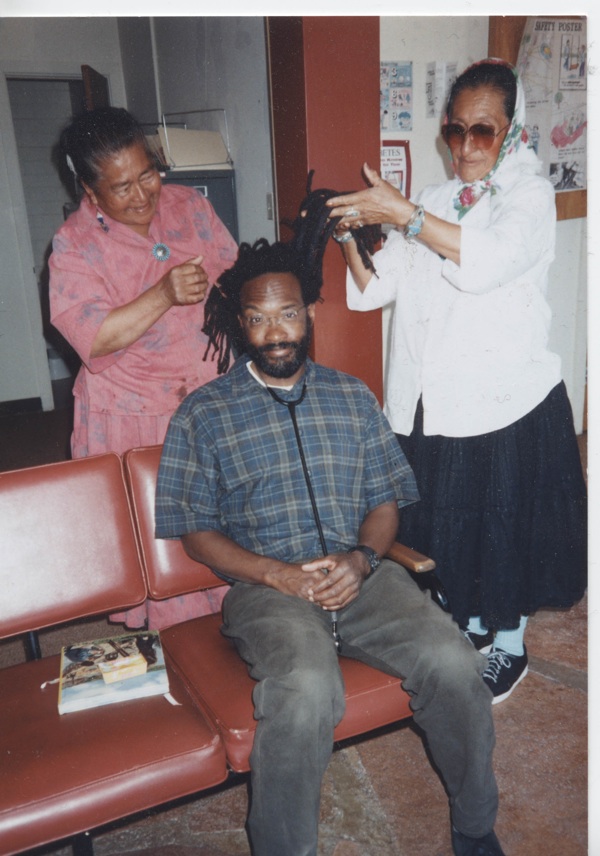
grandma’s checking out the dreads, circa 1995.
How has this connection affected your view on America’ s politics?
You know, during the period of slavery, it was common for escaped slaves to find refuge with surrounding Indian tribes. When I first came here I described my being here the same way in that I didn’t have to deal with the day to day racism I’d experienced in the south where I’m from. However, there’s racism here as well. Yet, I feel accepted in the community where I work and hope this comes from people appreciating my commitment to them and to the service I provide.
The Navajo Nation is rich in 5 natural resources. These include coal, natural gas, uranium, timber and water in aquifers. Because of the way contracts were written with the various companies exploiting these resources, the Navajo Nation is treated very much like a colony. The Navajo Nation should be the wealthiest group of people living in the U.S. but because of contractual exploitation, in fact, are amongst the poorest. This insight deepens my commitment to wanting to help people improve the quality of their lives through my medical practice and through what is hopefully uplifting and inspiring art.
It was a fellow physician who said “…the true revolutionary is guided by a great feeling of love.” Yeah, that was Ché.
What do you site as your most life changing event that set you on the path you are on now?
The junior high school experience at the alternative, Quaker school was all about living simply so others can simply live (cliché but true), living honestly and openly and treating others with respect. This experience profoundly affected my life. They also emphasized questioning authority and being a contributing member to your community. I remember spending my 8th grade year watching my dorm parent sweat through his appeal to the draft board as he sought conscientious objector status from the Viet Nam war (which he received). My experience at that school (the Arthur Morgan School in the mountains of North Carolina) leads me to wonder to this day how art can be used to create community. I’m trying to figure this out as I pursue the wheat pasting project on the rez.
Also while at this school, we always did team building exercises frequently in the form of group hikes. We were taught to be considerate of others and on the hikes, the fastest hiker always had to wait for the slowest of the group and to be cognizant of the pace. We were taught to respect nature and to leave only footprints when outside. I think this experience not only enhanced my sense of empathy but fueled my love of nature. Years later I thought of the Quaker experience when I accepted an offer to cycle 12,000 miles from the top of Africa to the bottom as team doctor. This was in 1992.
Along with Dan Buettner, three of us cycled the length of Africa and got a Guinness World Record for our efforts. We finished in South Africa 9 months before the election in which Mandela was elected president. It was still during apartheid. In fact, we were in Cross Roads, the squatter camp outside Cape Town the day the American Fullbright scholar from STanford, Amy Elizabeth Biehl, was bludgeoned to death for being white. As you can imagine, this experience was mind blowing as well. (http://www.rjgeib.com/heroes/amy/amy.html) But yeah, that trip was a life changing event for me. For one thing, all that I needed to live comfortably I was able to carry on a bicycle for 9 and 1/2 months. I think of that now when I look around and see all of the unnecessary clutter in my life. Reduce, reduce, reduce…
Do you feel you will continue using photography as your main form of self expression?
Yeah.
Peace and love man.
ct
Check out Chip’s blog here
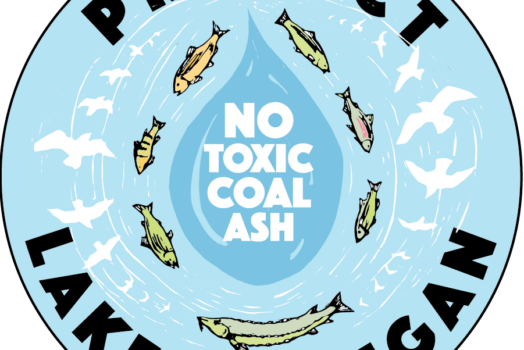
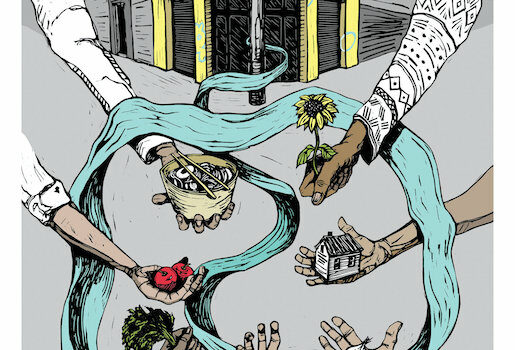
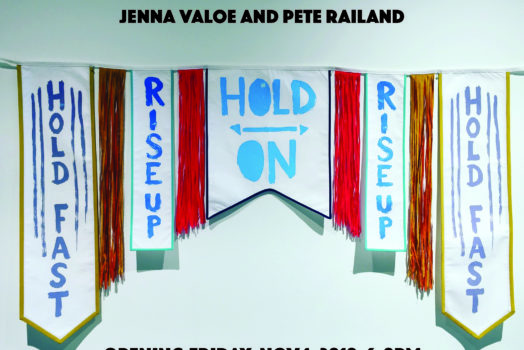
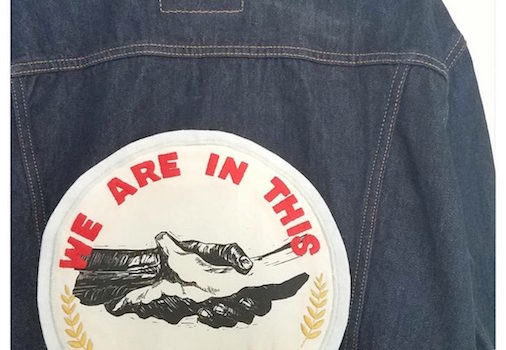
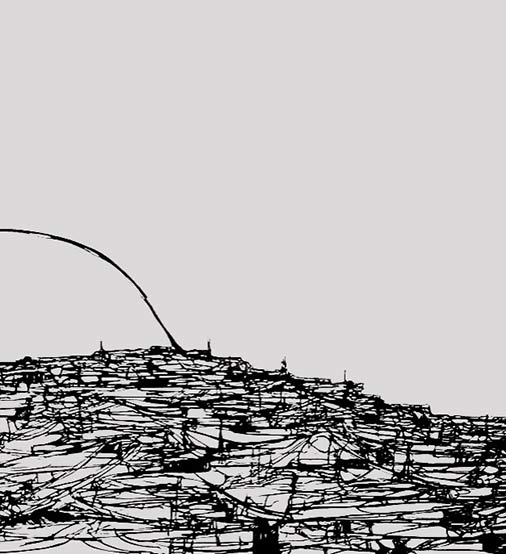
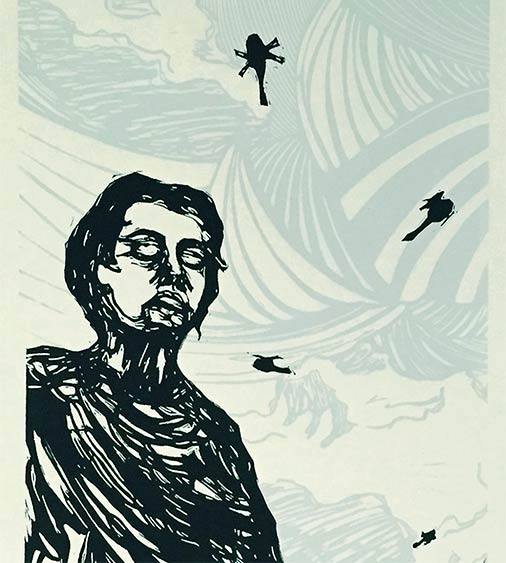
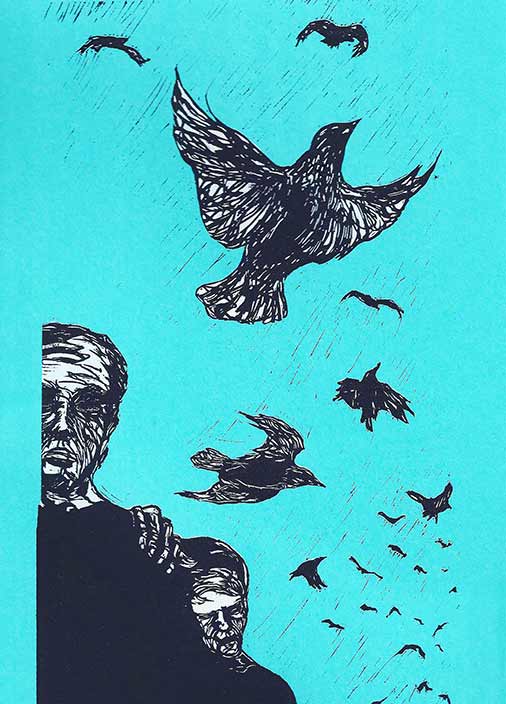
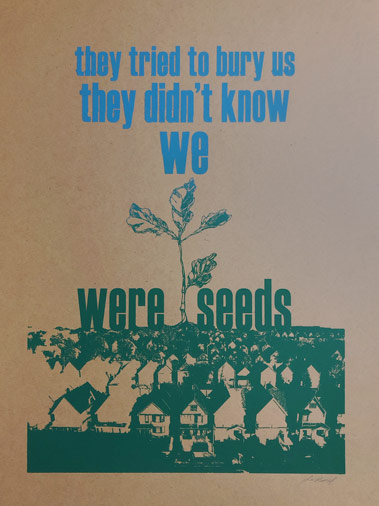
Wow! What a great interview! It’s really awesome to see all this work and some of the context it lies in. Thanks Chip, Chris and Pete!
Great to learn more about Chip Thomas. His work and his path is really inspiring.
Truely an inspiration for us all. As an ex-wheatpaste consumer and unknown drawer of drawings, I humbly thank you for your work and presence in our community.
My kids and I really were intrigued by your art last week as we were traveling from Monument Valley to the Grand Canyon.
Do you have a book available or photos of your work for sale?
I am just blown away. I was traveling past this work just a week ago and just KNEW I had to know more. In all aspects: a high school art teacher, a mother, a wife, sister and woman – I am inspired. Deeply inspired.
Thank You Chris and the creators of this wonderful blog.
Erin
Gunnison, Colorado
You are a story within a story Chip:)!
xo Mei